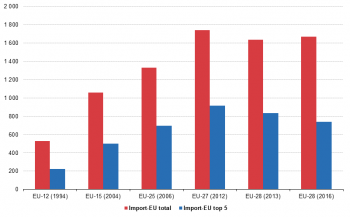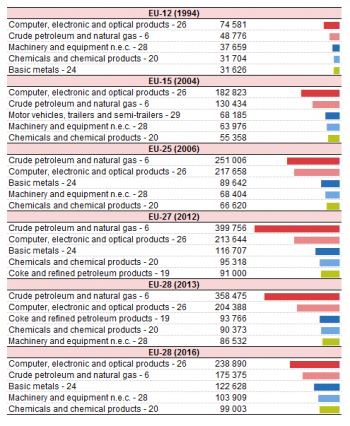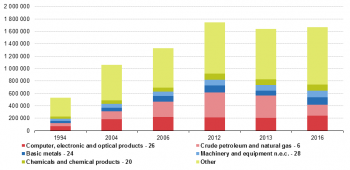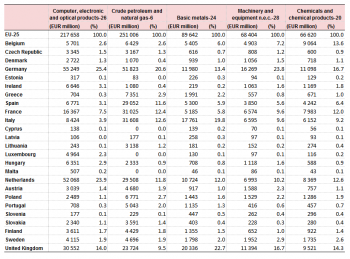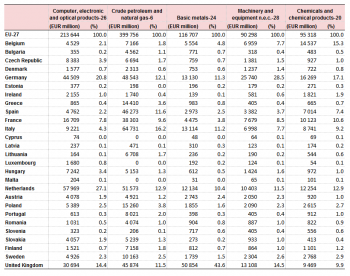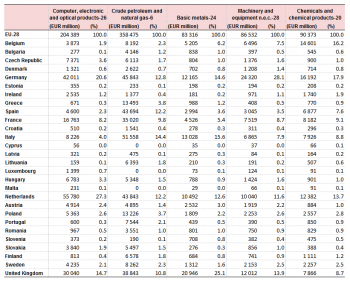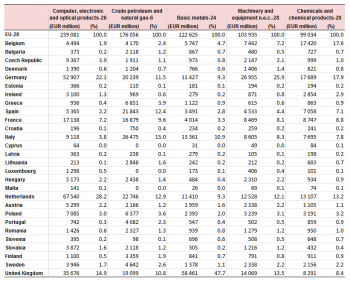Archive:Main goods in extra-EU imports
- Data extracted in Month YYYY. Most recent data: Further Eurostat information, Main tables and Database. Planned article update: (dd) Month YYYY(, hh:00).
Main statistical findings
Evolution of extra-EU imports
The value of imports between EU Member States has grown from EUR 732 billion in 1994 to EUR 3 072 billion in 2015 (see Figure 1). It must be noted that this rise reflects to a large extent the increase in the composition of the EU over this period.
Over the same time period, trade between the EU and the rest of the world tripled, from EUR 537 billion in 1994 to EUR 1 791 billion in 2015 [1].
Considering that the intra-EU trade data are based on common and largely harmonised rules, one might expect the intra-EU trade balance to be zero or at least close to it, meaning that at the EU aggregate level, total imports should equal total imports.
In theory for the EU aggregate, as intra-EU imports are declared free-on-board-type (FOB-type) value and intra-EU imports Cost-insurance-and-freight-type (CIF-type) value, the value of intra-EU imports should be slightly higher than that of intra-EU imports. However, since the introduction of the Intrastat data collection system for intra-EU trade on 1 January 1993, the value of intra-EU imports at the EU aggregate level has been consistently higher than that of intra-EU imports, showing that total intra-EU imports have better coverage than total intra-EU imports. The analysis presented in this section at the EU aggregate level only considers intra-EU imports as it is the more reliable measure of total intra-EU trade.
Figure 1 shows that the value of imports of all goods within the EU increased from 1994 to 2015. In 1994, total intra-EU imports stood at EUR 732 billion, while 10 years later, in 2004, this value had more than doubled to EUR 1 628 billion. By 2006, intra-EU imports had more than tripled, reaching EUR 2 321 billion. There was a continued increase in the total value of intra-EU imports since 2006 however the percentage increase was much lower.
The evolution of the value of the top 5 products imported within the EU follows roughly the same pattern as the total imports. In 1994, the value of the top 5 goods imported to other EU Member States was EUR 369 billion or just over half the value of all goods imported within the EU. In 2004 (EUR 822 billion) and 2006 (EUR 1 179 billion), the top 5 intra-EU imported goods by value also accounted for over half of intra-EU goods imports. By 2013 the relative importance of the top 5 goods traded within the EU had decreased to 44 % but it rose to 46 % of the value of total intra-EU imports in 2015.
The 5 most significant products in intra-EU trade
There has been a degree of consistency in those goods that have been most significant in terms of value imported within the EU, although some variations in the evolution of the import figures for these goods can be seen.
In 1994 the top 5 intra-EU imported products by value (see Table 1) were ‘Motor vehicles, trailers and semi-trailers’ (EUR 96 billion) followed by ‘Chemicals and chemical products’ (EUR 77 billion), ‘Computer, electronic and optical products’ (EUR 71 billion), ‘Food products’ (EUR 65 billion) and ‘Machinery and equipment’ (EUR 61 billion).
Ten years later, in 2004, the top 5 intra-EU imported goods were the same but in a different order (except for ‘Motor vehicles, trailers and semi-trailers’, which kept the top spot). In 2006, ‘Basic metals’ (EUR 160 billion) replaced ‘Food products’ as the fifth most imported product in intra-EU trade. However, in 2012, 2013 and 2015, the top 5 intra-EU imported goods by value were again the same as in 1994 albeit in a slightly different order.
The evolution of the value of the top 5 products imported within the EU follows a similar trend. In 1994, the value of the top 5 goods imported to other EU Member States was EUR 369 billion or just over half the value of all goods imported within the EU. In 2004 (EUR 822 billion) and 2006 (EUR 1 179 billion), the top 5 intra-EU imported goods by value also accounted for over half of intra-EU goods imports. By 2012 and 2013, the relative importance of the top 5 goods traded within the EU had decreased to between 46 % and 47 % of the value of total intra-EU imports (EUR 1 238 billion in 2012, EUR 1 253 billion in 2013).
The evolution of the 5 most traded intra-EU products (Figure 2) shows that ‘Motor vehicles, trailers and semi-trailers’ had the highest value of imports compared to the other most significant products. Figure 2 also shows that the greatest increase for all of the top 5 products in the value of intra-EU imports took place during the period of greatest EU expansion (1994–2006) as one might expect. This increase also reflects increases in prices and actual volumes traded within the EU over the period. After 2006 the value of imports within the EU for both ‘Motor vehicles, trailers and semi-trailers’ and ‘Computer, electronic and optical products’ fell. In 2006 the import figures were EUR 318 billion and EUR 297 billion respectively, falling in 2012 to EUR 303 billion and EUR 233 billion respectively.
The fall in the value of imports of ‘Computer, electronic and optical products’ continued between 2012 and 2013, and over the period 2006–13 they fell by 24 % but recovered strongly by 2015 gaining 21 % compared to 2006. imports of ‘Motor vehicles, trailers and semi-trailers’ exhibited a more stable trend, dropping by 5 % from 2006 to 2012, but recovering slightly between 2012 and 2013 followed by strong growth of 24 % between 2013 and 2015.
For the remaining three product types Figure 2 shows a continued increase until 2012 after which the trend levels out to 2013 but picks up again after that.
Figure 3 shows that the trend in the aggregate figure for the top 5 product types is generally reflected in the individual trends for those product types. The reduction in the total share of the top 5 product imports is due to the shrinking shares of ‘Chemical and chemical products’ (-1 %), ‘Computer, electronic and optical products’ (-1 %) and ‘Food products’ (-2 %).
Intra-EU trade of the most traded goods by Member State
The analysis in this section looks at intra-EU trade by individual EU Member State. For this analysis we consider each EU Member State’s trade in goods with its EU partners by looking at the sum of its imports and imports. Since EU Member States’ trade with the rest of the EU is considered as an aggregate figure we are unable to examine any changes in the importance of individual bilateral trade relationships. Table 2 shows that in 1994, Germany was the leading trading nation in the EU with the highest total volume trade in the 5 most significant products (‘Motor vehicles, trailers and semi-trailers’ EUR 49 billion; ‘Chemicals and chemical products’ EUR 35 billion; ‘Computer, electronic and optical products’ EUR 31 billion; ‘Food products’ EUR 25 billion and ‘Machinery and equipment’ EUR 32 billion). France was ranked second in 4 of these 5 products (the United Kingdom was second for ‘Computer, electronic and optical products’). Greece, Portugal and Ireland had the lowest total volume trade in the 5 most significant products.
Tables 2 to 6 show that over the 1994–2013 period the larger economies in the EU continued to have the highest trade values for the 5 most significant products. However, as might be expected, the trade value of the EU-12 Member States as a proportion of total intra-EU trade decreased as the EU expanded. For ‘Motor vehicles, trailers and semi-trailers’, ‘Computer, electronic and optical products’ and ‘Food products’ the EU-12 accounted for 70–75 % of the total intra-EU trade in these products by 2013. For ‘Chemicals and chemical products’ and ‘Machinery and equipment’ (EUR 32 billion) the EU-12 accounted for over 80 % of the total intra-EU trade in these products by 2013.
From 1994 to 2013 intra-EU trade in ‘Motor vehicles, trailers and semi-trailers’ more than tripled from EUR 49 billion to EUR 166 billion. With the exception of Greece, all other EU Member States registered an increase in this sector. Over the period Germany remained the largest trader by value of ‘Motor vehicles, trailers and semi-trailers’ with the value of its trade to other EU Member States more than tripling between 1994 and 2013, although this value has been relatively stable since 2006. Germany's relative share of intra-EU trade of motors remained at over one quarter of the total. This growth was driven by both increases in the price of these goods and changes in the composition of the EU as well as any increase in the volume of trade of motors.
For intra-EU trade in ‘Chemicals and chemical products’, Germany again had the largest share of trade throughout the period with between 19 % and 23 % of the EU total, more than tripling in value — from EUR 35 billion in 1994 to EUR 121 billion in 2013. France’s share fell over the same period from 17 % (second place in 1994 with EUR 22 billion) to 11 % in 2013 (fourth place with EUR 61 billion). In 2013 the Member States that joined the EU from 2004 onwards made up 11 % of the trade in chemicals. Poland ranked eighth in this sector in 2013 with 4 % of the total intra-EU trade following a 29 % increase from 2006 to 2013 (from EUR 15 billion to EUR 20 billion).
The share of ‘Computer, electronic and optical products’ in total intra-EU trade grew between 1994 and 2006 from 10 % to 13 %. In 2012 the percentage dropped to 9 % and to 8 % in 2013. With an increase in value of EUR 320 billion over this period, intra-EU trade of ‘Computer, electronic and optical products’ more than doubled. Germany maintained the highest share of this sectors’ trade during this period, reaching 26 % in 2013. Although for the United Kingdom, intra-EU trade in this sector grew by 35 % from 1994 to 2013, its share in the total EU trade of ‘Computer, electronic and optical products’ went down from 18 % to 7 %. The Netherlands showed a similar pattern in trade in this product type with a decrease of 9 percentage points during the same period.
The Member States that joined the EU from 2004 onwards have made a contribution to the increase of intra-EU trade in this sector. Their share has increased from 4 % in 2004 to 11 % in 2012 and 16 % in 2013. Poland and the Czech Republic both had a 4 % share of the intra-EU trade of ‘Computer, electronic and optical products’ in 2013 and both EU Member States have showed increases from 2006 to 2013 (from EUR 10 billion and EUR 7 billion in 2006 to EUR 19 billion and EUR 17 billion in 2013, respectively).
The intra-EU trade of ‘Food products’ as a proportion of total intra-EU trade has remained stable, ranging from 8 % to 9 %, and in value this sector showed an increase of EUR 312 billion from 1994 to 2013. The largest share of total trade continues to be held by Germany and in 2013 it was closely followed by the Netherlands. In fact, the Netherlands has gained importance in this area, growing from a 6 % share in 2004 to a 17 % share in 2013. The Member States that have joined the EU since 2004 held more than a fifth (21 %) of total EU trade in this sector in 2013. Of the 12 EU Member States that reported figures in 1994, only Greece registered a decrease in the value of intra-EU trade in food products.
Intra-EU trade in ‘Machinery and equipment’ was the sector which showed the smallest increase in value terms (EUR 298 billion), but the highest growth rate (with its value of EUR 413 billion in 2013 over three times the figure in 1994 of EUR 115 billion). Intra-EU trade in this sector increased in all EU Member States. Germany had the highest share throughout the years under consideration; however its share in total intra-EU trade in this sector has decreased from 28 % in 1994 to 18 % in 2013. This was also the case for France, the United Kingdom, Italy and the Netherlands. The other EU-12 countries registered an increase in their share of intra-EU trade in ‘Machinery and equipment’. The share of intra-EU trade in this sector for the 13 EU Member States who have joined the EU since 2004 was 13 % in 2013.
Intra-EU trade of the most traded goods by Member State, 2013-2015
Between 2013 and 2015 the composition of the EU remained the same. Nevertheless imports in all of the top 5 traded products increased. Germany was the largest importer in each of the top 5 products. The highest increase of intra-EU imports between 2013 and 2015 occurred in "Motor vehicles" (+25 %), where the United Kingdom's import share increased the most (+0.8 p.p.) while France's declined most (-0.9 p.p). There was more moderate growth in "Computers and electronics" and in "Machinery and equipment" of +16 % and +11 % respectively. The largest fluctuations in these two group were in French imports in "Computers and electronics" which fell -0.6 p.p. In "Machinery and equipment" Poland's imports increased by 0.7 p.p. Growth was rather small in "Food products" (+5 %) and "Chemical products" (+ 3 %) without much change in countries shares of the EU imports.
There were four countries that gained market share in each of the top 5 trade products namely Czech Republic, Ireland, Spain and Croatia. There were three countries that lost market share in each of the 5 top traded products, namely Estonia, France and Sweden. Of these three France (+16 billion EUR) and Sweden (+5 billion EUR) nevertheless saw their imports in absolute terms rise. Only Estonia saw its imports in absolute terms fall (-234 million EUR), a feat it shared with Malta (-128 million EUR) . Croatia (+38 %) and Czech Republic (+24 %) saw the highest growth rate of their imports in the top 5 traded products.
Data sources and availability
EU data comes from Eurostat’s COMEXT database.
COMEXT is the Eurostat reference database for international trade in goods. It provides access not only to both recent and historical data from the EU Member States but also to statistics of a significant number of non-EU countries. International trade aggregated and detailed statistics disseminated from Eurostat website are compiled from COMEXT data according to a monthly process. Because COMEXT is updated on a daily basis, data published on the website may differ from data stored in COMEXT in case of recent revisions.
European statistics on international trade in goods are compiled according to the EU concepts and definitions and may, therefore, differ from national data published by Member States.
Product classification
Classification of products by activity (CPA) is a statistical classification of products and services obligatory for all EU Member States. CPA classifies products by activity in which they are produced. Products are transportable goods and services. The CPA is a product classification whose elements are related to activities as defined by NACE Rev. 2. Each product - whether it be a transportable or a non-transportable good or a service - is assigned to one single NACE Rev. 2 activity. The linkage to activities as defined by NACE Rev. 2 gives the CPA a structure parallel to that of NACE Rev. 2 at all levels distinguished by NACE Rev. 2.
Unit of measure
Trade values are expressed in millions (106) of euros. They correspond to the statistical value, i.e. to the amount which would be invoiced in case of sale or purchase at the national border of the reporting country. It is called a FOB value (free on board) for exports and a CIF value (cost, insurance, freight) for imports.
Context
The automobile industry remains of prime importance for the EU, producing about a quarter of the world total of motor vehicles. The industry accounts for 5 % of employment in the EU and is an important contributor to many of the EU's national economies. In Germany, for example, the industry's share in manufacturing as a whole is close to 20 %, according to the European Automobile Manufacturers' Association. Trade in new and used motor vehicles accounts for a substantial part of the EU total, with close to 6 % of the total value of all extra-EU exports in 2011. The industry has suffered from the financial crisis which started in 2008 and is also under pressure from environmental regulation to curb tailpipe emissions.
See also
Further Eurostat information
Data visualisation
- Did you know? Some funny and curious facts about trade of the EU
- Top 5 partners in trade in goods
- My Country in a bubble
Main tables
- International trade in goods - long-term indicators (t_ext_go_lti)
- International trade of machinery and transport equipment (SITC 7), by declaring country (tet00009)
- Extra-EU28 trade of machinery and transport equipment (SITC 7), by Member State (tet00059)
- Extra-EU28 trade of machinery and transport equipment (SITC 7), by main partners (tet00030)
- International trade in goods - short-term indicators (t_ext_go_sti)
- Imports of goods - machinery and transport equipment (teiet170)
- Exports of goods - machinery and transport equipment (teiet070)
Database
- International trade in goods - aggregated data (ext_go_agg)
- International trade in goods - detailed data (detail)
Dedicated section
Methodology / Metadata
- International trade in goods statistics - background
- International trade in goods (ESMS metadata file — ext_go_esms)
- User guide on European statistics on international trade in goods
Source data for tables, figures and maps (MS Excel)
Other information — Legal background
- Regulation (EC) No 471/2009 of 6 May 2009 on Community statistics relating to external trade with non-member countries
- Regulation (EU) No 92/2010 of 2 February 2010 implementing Regulation (EC) No 471/2009, as regards data exchange between customs authorities and national statistical authorities, compilation of statistics and quality assessment
- Regulation (EU) No 113/2010 of 9 February 2010 implementing Regulation (EC) No 471/2009 , as regards trade coverage, definition of the data, compilation of statistics on trade by business characteristics and by invoicing currency, and specific goods or movements.
External links
Notes
- ↑ From crisis to opportunity — putting citizens and companies on the path to prosperity — A better functioning internal market is a key ingredient for European growth’, European Commission, 2014.
[[Category:<Subtheme category name(s)>|Name of the statistical article]] [[Category:<Statistical article>|Name of the statistical article]]
Delete [[Category:Model|]] below (and this line as well) before saving!
